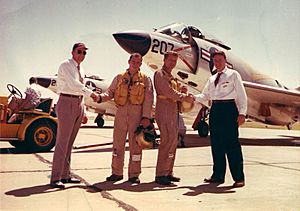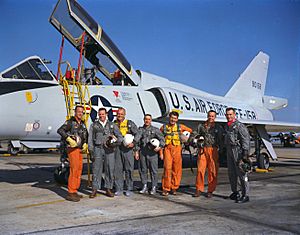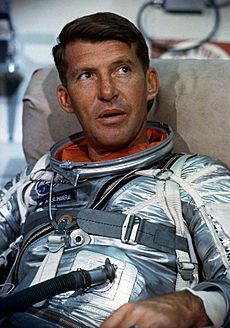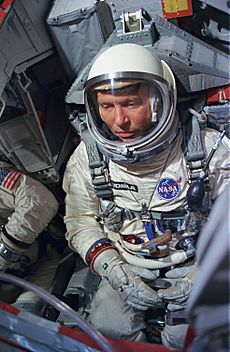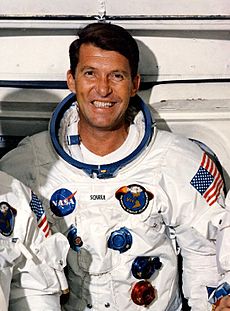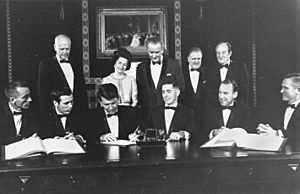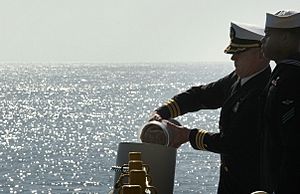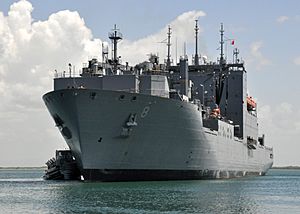Wally Schirra facts for kids
Quick facts for kids
Wally Schirra
|
|
|---|---|
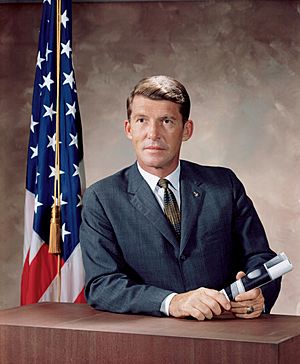
Schirra in 1964
|
|
| Born |
Walter Marty Schirra Jr.
March 12, 1923 Hackensack, New Jersey, U.S.
|
| Died | May 3, 2007 (aged 84) San Diego, California, U.S.
|
| Alma mater |
|
| Occupation |
|
| Awards |
|
| Space career | |
| NASA astronaut | |
| Rank | Captain, United States Navy |
|
Time in space
|
12d 7h 12m |
| Selection | 1959 NASA Group 1 |
| Missions |
|
|
Mission insignia
|
 |
| Retirement | July 1, 1969 |
Walter Marty Schirra Jr. (March 12, 1923 – May 3, 2007) was an American Navy pilot, test pilot, and NASA astronaut. In 1959, he became one of the first seven astronauts chosen for Project Mercury. This was the United States' first plan to send people into space.
On October 3, 1962, Schirra flew the Mercury-Atlas 8 mission. His spacecraft was called Sigma 7. He orbited Earth six times in nine hours. At that time, he was the fifth American and ninth person to travel into space.
Later, in the two-person Gemini program, he made history. In December 1965, he achieved the first space rendezvous. He flew his Gemini 6A spacecraft very close to the Gemini 7 spacecraft.
In October 1968, he commanded Apollo 7. This was an 11-day test flight of the three-person Apollo Command/Service Module. It was the first crewed launch for the Apollo program. Schirra was the first astronaut to fly in space three times. He was also the only astronaut to fly in the Mercury, Gemini, and Apollo programs. In total, he spent over 295 hours in space.
Before becoming an astronaut, Schirra served in the Navy. He fought in World War II and the Korean War. He retired from the Navy in 1969 as a Captain. After leaving NASA, he worked as a consultant for CBS News. He helped cover NASA's Moon landing missions.
Contents
Early Life and Education
Walter Schirra Jr. was born on March 12, 1923. His hometown was Hackensack, New Jersey. His family had a history of flying. His father flew planes in World War I. His mother performed wing walking stunts.
Schirra grew up in Oradell, New Jersey. He was a Boy Scout. In 1940, he finished Dwight Morrow High School. He then went to the New Jersey Institute of Technology. After the attack on Pearl Harbor in 1941, he wanted to join the military. He chose the United States Naval Academy. He graduated in 1945 with a degree in science. The Naval Academy had a faster program during wartime.
Military Service
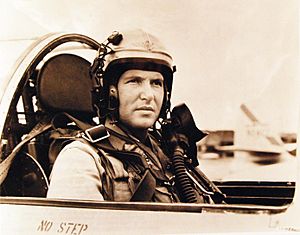
After graduating, Schirra joined the United States Navy in 1945. He served on a large cruiser during the end of World War II. After the war, he trained to become a Naval Aviator. In 1948, he earned his pilot wings. He flew F8F Bearcat planes.
When the Korean War started in 1950, Schirra was deployed. He joined an exchange program with the U.S. Air Force. He flew F-84 Thunderjet planes. During his eight months in Korea, he flew 90 combat missions. He shot down two enemy planes.
After Korea, Schirra became a test pilot. He tested new weapons systems. He was the first pilot to fly with and fire the Sidewinder missile. He also tested new Navy jet fighters. In 1958, he attended the United States Naval Test Pilot School. He learned to fly many different aircraft. After graduation, he continued to test planes for the Navy.
NASA Career
Project Mercury
In 1959, NASA chose 110 military test pilots. Schirra was one of them. They were candidates for Project Mercury. This was the first U.S. program to send people into space. In April 1959, Schirra was selected as one of the original seven astronauts.
Schirra helped design the spacecraft. He also worked on the life-support systems. On October 3, 1962, Schirra launched into space. His Mercury spacecraft was called Sigma 7. Once in orbit, Schirra showed he could control the spacecraft himself. He used a special system to move it. This was important because of earlier navigation problems.
Schirra also had to fix his suit's cooling system. It got too hot, reaching 32 degrees Celsius (90 degrees Fahrenheit). He adjusted it manually. He proved that astronauts could fly the spacecraft even if automatic controls failed. After six orbits, Sigma 7 landed safely in the Pacific Ocean. Schirra opened the hatch himself. This showed that another astronaut, Gus Grissom, had not opened his hatch on purpose during an earlier flight.
Project Gemini
Schirra was chosen for the Project Gemini program. He and Tom Stafford were the backup crew for Gemini 3. Then they became the main crew for Gemini 6. Gemini 6 was supposed to dock with another spacecraft. But that spacecraft exploded during its launch in October 1965.
So, NASA changed the plan. Gemini 6A would try to meet Gemini 7 in space. Gemini 7 launched on December 4, 1965. Gemini 6A tried to launch on December 12. But its engines shut down just before liftoff. Astronauts were supposed to eject in such a case. But Schirra decided not to. This saved them from possible injuries.
Gemini 6A launched successfully on December 15. It met Gemini 7 after five hours. The two spacecraft flew within one foot of each other. They stayed close for five hours. This was the first space rendezvous. After this, Gemini 6A returned to Earth.
While in space, Schirra played a Christmas joke. He pretended to see a UFO. Then he played "Jingle Bells" on a harmonica he had hidden. His crewmate, Stafford, played sleigh bells.
Apollo Program
In 1966, Schirra was chosen to command an Apollo crew. His crew would test the Apollo Command/Service Module. This was the second crewed flight test. Schirra's crew became the backup for the Apollo 1 crew.
On January 27, 1967, a fire killed the Apollo 1 crew during a test. Schirra's crew then became the main crew for the first crewed flight. This mission was named Apollo 7. It was delayed until 1968. Safety improvements were made to the Command Module. Schirra insisted that a specific launch expert, Guenter Wendt, be in charge of his spacecraft.
Apollo 7 launched on October 11, 1968. Schirra became the first person to fly in space three times. In orbit, the crew practiced meeting and docking with the rocket stage. This was to prepare for retrieving the Apollo Lunar Module. On the second day, the crew broadcast the first live television pictures from space.
During the mission, Schirra got a head cold. He passed it to his crewmate, Donn Eisele. Schirra suggested that they not wear their helmets during reentry. Even though Mission Control asked them to, they refused. They reentered Earth's atmosphere without their helmets. Apollo 7 landed safely on October 22, 1968.
Before the Apollo 7 launch, Schirra decided to retire. He left the NASA Astronaut Corps on July 1, 1969. He also retired from the Navy as a Captain.
Post-NASA Career
Television Career
Schirra became a spokesman for a cold medicine called Actifed. This was because he had a head cold during his Apollo 7 mission. The cold medicine he used in space was similar to Actifed.
From 1969 to 1975, he worked for CBS News. He joined Walter Cronkite to cover the seven Moon landing missions. This included Apollo 11 and the difficult Apollo 13 mission.
Business Career
After NASA, Schirra worked in business. He was a president and director for a financial company. He also formed an environmental control company. He helped develop an Alaskan oil pipeline. He was on an advisory board for U.S. National Parks.
In 1979, Schirra started his own consulting company. He also served on the boards of several corporations. In 1984, he and the other surviving Mercury astronauts started the Mercury Seven Foundation. This group now gives college scholarships to science and engineering students.
Writing Career
Schirra co-wrote the 1962 book We Seven. It described the training for the Mercury program. In 1988, he released his autobiography, Schirra's Space. He also co-authored Wildcats to Tomcats: The Tailhook Navy in 1995. This book covered five decades of Naval aviation. In 2005, he co-wrote The Real Space Cowboys. This book told the story of the Mercury Seven astronauts. His last work was a contribution to the 2007 book, In the Shadow of the Moon.
Personal Life
Walter Schirra married Josephine Cook "Jo" Fraser in 1946. They had two children, Walter III and Suzanne. Jo Schirra passed away in 2015.
Death
Schirra died on May 3, 2007. He was 84 years old. He passed away from a heart attack while being treated for abdominal cancer. A memorial service was held for him in California. His ashes were released into the sea on February 11, 2008. This burial at sea ceremony took place aboard the aircraft carrier USS Ronald Reagan.
Awards and Honors
Schirra received many military awards. These included three Air Medals and three NASA Distinguished Service Medals. He also received the NASA Exceptional Service Medal. He earned a Distinguished Flying Cross for his service in the Korean War. He received two more gold stars for his space flights.
Schirra was honored with several civilian aviation awards. He received the Harmon Trophy in 1965. He was also given the Robert J. Collier Trophy in 1962 with the other Mercury 7 astronauts.
He was inducted into many halls of fame. These include the International Air & Space Hall of Fame (1970) and the U.S. Astronaut Hall of Fame (1990). The ship USNS Wally Schirra (T-AKE-8) was named after him in 2009. A street, a park, and an elementary school are also named in his honor.
In Film and Television
- 1983 film The Right Stuff – played by Lance Henriksen
- 1998 HBO miniseries From the Earth to the Moon – played by Mark Harmon
- 2015 ABC series The Astronaut Wives Club – played by Aaron McCusker
- 2020 Disney+/National Geographic miniseries The Right Stuff – played by Aaron Staton
See also
 In Spanish: Walter M. Schirra para niños
In Spanish: Walter M. Schirra para niños


